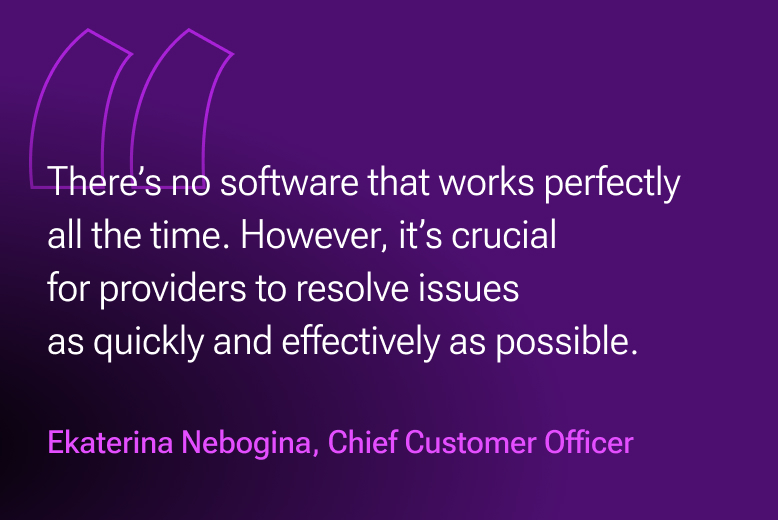For an iGaming software provider, it’s not enough just to deliver quality software to clients. The key lies in how successfully the operator uses that software, making high-quality customer support critically important. With over 20 years of industry experience, we’ve learned a great deal, though we continue to evolve. This article outlines common pitfalls in organising support services.
Mistake 1: Incorrect Assessment of Task Urgency
The urgency of a task can be assessed using two main criteria: business impact and security. Support staff may misjudge task priorities, potentially leading to severe consequences.
Why It Happens
Level 1 support staff, who communicate directly with clients, often lack sufficient information about the problem and may, therefore, misjudge its urgency when passing it to the Level 2 team.
Risks
A misassigned priority could delay problem resolution, leading to significant losses for both the operator and the provider.
How to Avoid It
- Ask Questions: Establish a set of clarifying questions for support staff to gather sufficient details when a problem arises. At EvenBet Gaming, for example, we’ve created specific runbooks that outline detailed instructions for staff.
- Train Staff: Support teams should be almost as knowledgeable about the product as any team member, with deep onboarding and ongoing updates about new features. At EvenBet Gaming, we have checkpoints and regular meetings to train support staff on all product updates.
Mistake 2: Putting Support Staff to Work Independently Too Soon
Support staff should handle tasks at their level competently. However, it’s not uncommon for staff to be assigned full shifts before they’re truly ready.
Why It Happens
This often occurs due to staffing shortages, with management assuming employees can fill knowledge gaps on the job.
Risks
If Level 1 staff can’t resolve issues at their level, they’ll escalate them unnecessarily to Level 2, adding pressure on the development team and delaying other clients’ issues.
How to Avoid It
Management should understand that “on-the-job training” during full shifts is costly. Streamlining onboarding is essential to reduce the time it takes for new hires to work independently.

Mistake 3: Skipping Onboarding for the Client
Online poker products have a high entry barrier. Even if a client has experience with other poker platforms, each provider’s software is unique.
Why It Happens
Providers may skip client onboarding due to time constraints or lack of interest, though clients may also opt out, thinking they can figure it out on their own. Another factor may be inconvenient training formats that hinder client teams’ understanding.
Risks
Without proper onboarding, clients may repeatedly contact support with minor questions, adding to the team’s workload and potentially misconfiguring their poker room, leading to revenue loss and player dissatisfaction.
How to Avoid It
Make every effort to convince clients of the need for pre-launch training and create diverse training materials, following content trends. Some users prefer in-depth documentation, while others learn best through videos, etc.
Mistake 4: Having Set Working Hours for Support
In some projects, support operates during set hours, like Monday to Friday from 9:00 am to 6:00 pm, while users play the game 24/7.
Why It Happens
This often results from insufficient client focus and a lack of human and financial resources.
Risks
It delays problem resolution and may lead to urgent after-hours calls to development staff, affecting team motivation.
How to Avoid It
Poker rooms operate 24/7, and support must match that. Round-the-clock support ensures swift responses and, for providers like EvenBet Gaming with a global client base, hiring support across different time zones is vital.
Mistake 5: Relying on Strict Scripts for Support
In many companies, support relies on strict scripts, often unsuitable for B2B, where clients expect a personalised approach.
Why It Happens
Scripted support often results from staff lacking product knowledge, and companies may view this as a substitute for training.
Risks
In B2B, clients are generally more involved in the way their project functions than typical B2C clients. So, this creates unnecessary back-and-forth, delaying resolution times. Additionally, it’s always obvious when support is following a script, which can frustrate clients who expect a personalised approach.
How to Avoid It
Invest in staff training. Support teams must understand the product thoroughly and each client’s project specifics. A well-trained support team should offer an individualised approach, quickly assessing and deciding the best course of action.

Mistake 6: Limited Communication Channels with Support
Restricting clients to a particular tool or communication channel for support can be a mistake. While it might simplify things for support staff, it detracts from the quality of service.
Why It Happens
Many companies favour one or two communication tools. Staff and management are accustomed to these tools, naturally wanting to offer the same options to clients for support.
Risks
For instance, if you require clients to use only Skype but they find it inconvenient or don’t typically use it, they’ll check it infrequently, which will lead to delays in addressing ongoing work matters. Clients will turn to the imposed communication tool only when the issue has worsened and the project is already in trouble.
How to Avoid It
Providers should focus on resolving client issues as quickly as possible, using communication tools that are convenient for the client’s team. This may include both various Support Desk options to track task status and instant messaging channels. Support staff should be trained to use all such tools effectively.
Mistake 7: Lack of Detailed Documentation and User Guides for Clients
Sometimes providers skip working on detailed resources for clients, or the available materials are outdated.
Why It Happens
It often comes down to cost-saving. Creating and updating guides requires ongoing resources, not just one-off investments.
Risks
While having no comprehensive resources isn’t inherently dangerous, good documentation helps both clients and support teams by reducing unnecessary workload. Often, clients will resolve issues independently if they have access to up-to-date guides, meaning less time spent on minor queries.
Otherwise, clients might go as far as to misunderstand system behaviour. For example, when monitoring the room’s operations, a client might notice that cards a player folded preflop have reappeared in the game. This could easily look like a bug to them, though it’s actually the feature called Reshuffle. Conversely, a genuine system malfunction could be mistaken for normal behaviour, potentially causing harm to the room at any time.
How to Avoid It
Maintain a team of technical writers who can update guides and documentation immediately after new features or changes are released.
Mistake 8: Lack of Transparency in Problem Resolution
It’s easy to assume that fixing a technical issue concludes the support request, which is a mistake for both providers and clients.
Why It Happens
Providers might believe that a technical fix alone resolves the problem, often wanting to close tasks quickly and move on.
Risks
Changes made during problem-solving can impact the client’s operations. Without a clear explanation, clients might misunderstand system behaviour, potentially causing operational issues. For example, something has been fixed, but now achieving the desired result requires ticking a checkbox or adjusting a configuration. The client is unaware of this and reopens the issue, as the platform continues to function as it did before.
How to Avoid It
Support teams should not only inform clients when an issue is resolved but also explain the solution and its implications for system management.
Mistake 9: Not Speaking the Client’s Language
Effective collaboration hinges on clear communication. It’s crucial to communicate with clients in both terminology and their native language when possible.
Why It Happens
Lack of language skills within support teams, coupled with a tendency to expedite tasks without considering the client’s comprehension can create issues.
Risks
Poor communication can lead to misunderstandings, client dissatisfaction, and more time spent clarifying queries.
How to Avoid It
Firstly, for work in countries where English is not widely spoken, it is advisable to employ support staff who can communicate in the local language. For example, EvenBet Gaming hires Spanish-speaking specialists for work in Latin America.
It’s also important to consider that the language of communication may not be the client’s native tongue. In such cases, support staff should be attentive to the client’s language proficiency and adjust their messages accordingly.
Additionally, at the start of communication, it’s crucial to ensure that both parties have a mutual understanding of terms and use consistent names for the same features. For example, we have a feature we call Rejoin Limits, though clients often refer to it as Anti-Banking or Anti-Ratholing. Our tournament feature, where players at the final table agree to split the prize pool among themselves, is called Share Prize, yet clients often call it Dealmaking.
If you notice a discrepancy in terminology with the client, first, discuss it with them, and second, include the client’s terminology in the descriptions of relevant features in the documentation. This way, even if a new support team member encounters a client-specific term, they can easily understand it with a simple search through the documentation.
Mistake 10. Neglecting Communication Etiquette
Client interactions require a professional standard, which is sometimes overlooked. Common communication etiquette errors in support include:
- Unprofessional nicknames
- Humorous or offensive avatars and statuses in messaging apps
- Political or religious statements in statuses or avatars
- Fragmented communication, with one idea spread across multiple messages
- Impoliteness or grammatical errors
- Excessive apologies
- Disregarding client concerns
- Unprofessional attire or backgrounds in video calls
- Joining calls with the camera off
- Slow response times
Why It Happens
Insufficient guidance or recruitment of staff with underdeveloped soft skills can lead to these issues.
Risks
Improper communication can greatly irritate or even offend a client. Poor language use can suggest a lack of competence within the team, which could ultimately harm the client relationship to the point of termination.
If support staff make jokes while discussing an issue, the client may feel that their problem—and by extension, their relationship with you—is being trivialised.
It’s essential to apologise for genuine mistakes. However, overly frequent apologies, offered solely out of a desire to appear as polite as possible, could lead the client to question the provider team’s competence.
How to Avoid It
Establish guidelines that regulate client communication through dedicated work accounts. A good approach is to include the company name and position in each employee’s username. For support staff, adding “Support Agent” to their name can be highly appropriate and convenient.
When hiring employees who will directly interact with the client team, prioritise soft skills. Additionally, it’s worth developing a detailed guide to business etiquette, even if it includes seemingly obvious points.
Why is This Important?
No software works perfectly all the time, and most clients understand this. However, it’s crucial for providers to resolve issues as quickly and effectively as possible and to demonstrate that they value their relationship with the client and take their needs seriously.
Effective organisation of the support service is a vital part of customer service. Software providers succeed not by selling large volumes of their product, but by building long-term client relationships that contribute to the client’s business success.




























